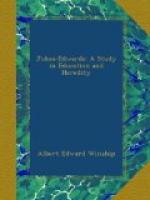Prof. Theodore William Dwight, LL.D., b. 1822, g. Hamilton 1840, g. Yale Law S.; professor Hamilton College sixteen years; dean of Columbia College Law S. from 1858 to 1892. James Brice of England placed him at the head of legal learning in the United States and said: “It would be worth an English student’s while to cross the Atlantic to attend his course.” Another eminent English lawyer, A.V. Dicey, in “Legal Education” wrote of him as “the greatest living American teacher of law.” He gave a course of lectures each year at Cornell; was a member of the N.Y. Constitutional Convention in 1867; was a member of the famous committee of seventy in N.Y. City that exposed the Tweed ring; was president of the New York Prison Association and presided when Mr. Dugdale was employed to study the Jukes; associate editor “American Law Register;” was legal editor of “Johnson’s Encyclopaedia,” and made many important contributions to the legal literature of the country. There have been few men of equal eminence in our country’s history.
President Theodore Dwight Woolsey, D.D., LL.D., b. New York City, October 31, 1801, was the grandson of Mary Edwards Dwight and great grandson of Jonathan Edwards; g. Yale 1820; studied at Princeton Theological Seminary and g. at Yale L.S.; studied in German universities; professor in Yale twenty-two years; president of Yale 1846-1871. Wesleyan conferred degree of LL.D. and Harvard that of LL.D. and S.T.D. all before he was fifty years of age. President of the Evangelical Alliance held in N.Y. City 1873, the leading American on the Committee for the Revision of the Bible. After resigning the presidency he continued to lecture at Yale until his death, 1889. There was no more eminent American in unofficial life from 1840 to 1890 than he. President Hayes once said that he was greatly perplexed at one time as to the line of public policy which he should pursue until it occurred to him that President Woolsey was the one American on whose judgment he could rely, and after consulting him his course was entirely clear and his action wise. He was the author of several valuable and standard works. Yale’s first great advance was in the time of President Timothy Dwight, its second was in the administration of President Theodore Dwight Woolsey. When he became president the classes about doubled in size. He introduced new departments at once and endowments came in, such as had never been considered possible. The tuition was raised from $33 to $90; the salaries were greatly increased, graduate courses were introduced; many new buildings were erected and everything went forward at a radically different pace. Yale and American thought owe much to President Woolsey. He wrote many scholarly works.
There were thirteen children born to President Woolsey. Of these, one daughter married Rev. Edgar Laing Heermance, a graduate of Yale and a useful and talented man; one of the sons, Theodore Salisbury, was a graduate of Yale, and professor of International Law at Yale.




